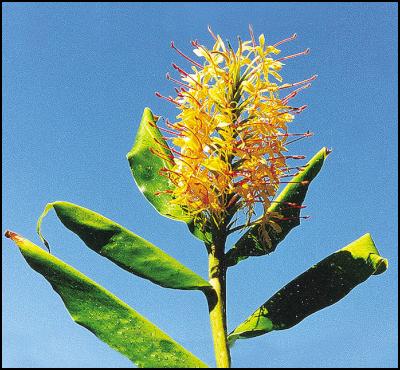Wild Ginger a threat to native bush
Thursday 27 July 2005
Wild Ginger a threat
to important coastal native bush

A single, rampant weed is threatening the biodiversity of native forests on the Bay of Plenty’s east coast.
A recent survey by Environment Bay of Plenty has found Kahili ginger growing wild over more than 600ha, and on 250 properties, between Torere and Whangaparaoa.
Pest plant coordinator John Mather says the infestations “seriously compromise” the high biodiversity and landscape values of the area, which hosts the largest tracts of coastal native forest in the North Island. “It poses possibly the greatest environmental threat to the coast,” Mr Mather says. “Without intervention, the situation will eventually become unmanageable.”
Wild ginger had steadily spread from original plantings along the coast to deep inside the bush. “The result, which is already clearly visible in some places, is a forest canopy with an understorey of pure ginger. This destruction of the natural process will eventually lead to the complete collapse of parts of the forest as old trees naturally die.”
Wild ginger is a Progressive Control Pest Plant in Environment Bay of Plenty’s Regional Pest Management Strategy. This means landowners or occupiers must control infestations on their properties. However, Mr Mather says the regulation is difficult to enforce because of fragmented land ownership and a small population base.
“We have a very small number of people pitted against a large area of wild ginger.” Individuals and voluntary groups, including marae committee and care groups, are making a “valiant effort”. “Everyone is genuinely concerned but equally genuinely unable to muster the manpower and resources to deal with such a large problem.”
Mr Mather says, for the future of biodiversity on the coast, control of the pest plant is critical. He will be presenting options for the task to the regional council’s next operational services committee meeting in early September.
Kahili ginger is a native of the Himalayan foothills and has been cultivated in New Zealand gardens since 1865. It was originally prized in gardens because of its spectacular flowers and strong scent. And it is very easy to grow - a single plant will spread to densely cover an area of many square metres. It is also spread further afield by birds which eat the small fruit, leaving the seeds in their droppings.
ENDS


 Gordon Campbell: Gordon Campbell On The Folly Of Making Apologies In A Social Vacuum.
Gordon Campbell: Gordon Campbell On The Folly Of Making Apologies In A Social Vacuum. NZ Government: NZ Signs Trade Deal With Costa Rica, Iceland And Switzerland
NZ Government: NZ Signs Trade Deal With Costa Rica, Iceland And Switzerland Forest And Bird: Modernisation Of Conservation System Must Focus On Improving Conservation
Forest And Bird: Modernisation Of Conservation System Must Focus On Improving Conservation NZCTU: Uniformed Defence Force Should Not Be Used As Strike Breakers
NZCTU: Uniformed Defence Force Should Not Be Used As Strike Breakers MetService: Damp Start To Canterbury Anniversary Weekend; Wet Start For Coldplay Fans In Auckland
MetService: Damp Start To Canterbury Anniversary Weekend; Wet Start For Coldplay Fans In Auckland RNZ: Senior Lawyers Call For Treaty Principles Bill To Be Abandoned
RNZ: Senior Lawyers Call For Treaty Principles Bill To Be Abandoned Lobby for Good: Small Business Owners, MPs Rally Together To Demand Transparency In Tauranga Marine Precinct Sale
Lobby for Good: Small Business Owners, MPs Rally Together To Demand Transparency In Tauranga Marine Precinct Sale


